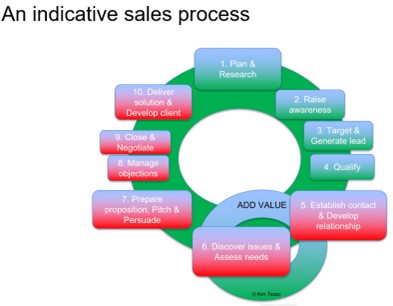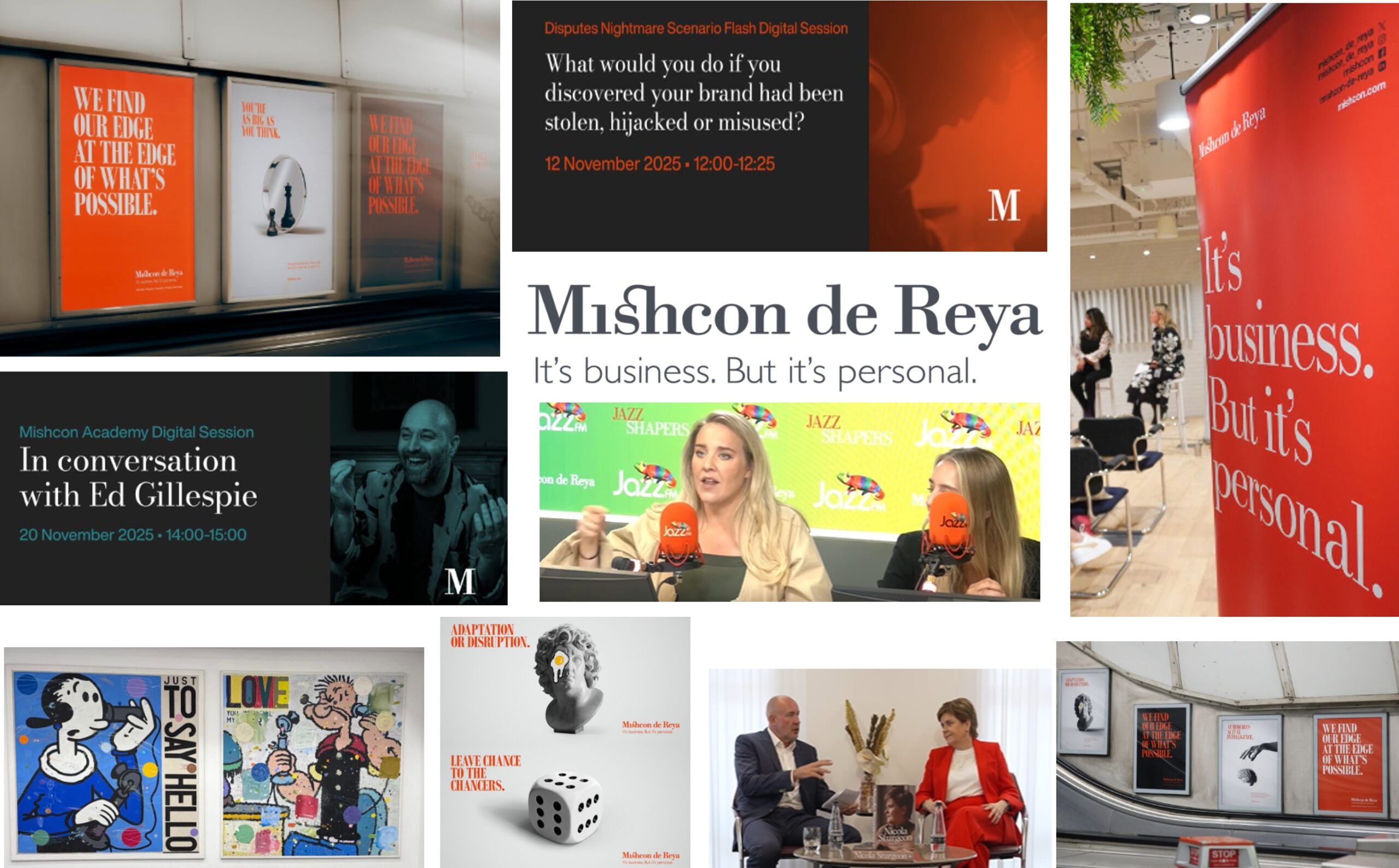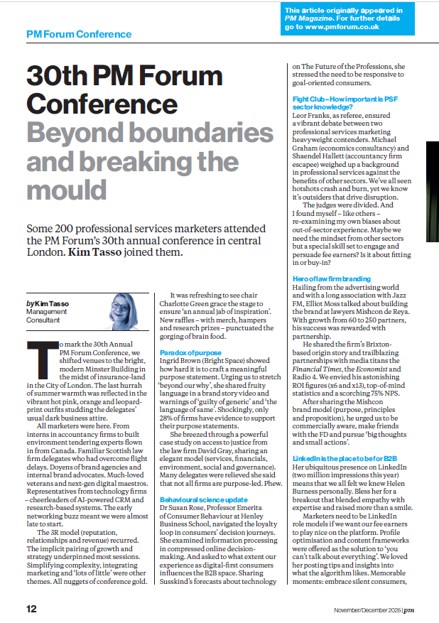
In early December we welcomed 15 delegates to a PM Forum “Be more strategic” workshop. The delegate aims, views and key takeaways are shown below. The workshop covered strategic thinking, business strategy and marketing and business development (MBD) strategy. We looked at case studies from professional services firms. From the animated discussions I selected a few topics of focus – Be more strategic: Top-down or bottom-up, marketing and sales integration and property marketing.
Top-down or Bottom-Up Strategy?
The complexity of professional services firms adds to the strategy challenge. Professional service firms are usually a collection of disparate and self-governing business units focusing on different markets and services.
Some think about a centralised or decentralised approach to strategy. Others see it more as top-down or bottom-up approach to strategy. But in essence it is about whether strategy is developed by a centralised leadership team or by those running the business units or divisions. The essence of strategy is about choices on how to achieve aims and how limited resources are used to achieve a competitive advantage.
Several delegates mentioned that they had responsibilities for strategy within particular sectors, service lines and territories. They reflected that often these strategies are developed by fee-earners in isolation and therefore don’t connect to the firm’s overall strategy or support those in other teams.
This relates to the hierarchy of plans – an organisation has strategies and plans at different levels such as corporate, business unit, functional (where marketing and business development often sits) and operations. It is vital that these strategies are aligned. See The 4 Levels Of Strategy: The Difference & How To Apply Them (cascade.app).
The bottom-up approach has the advantage of being well focused on the specific market conditions and client needs. And where people have developed their own strategy they are more likely to work towards its successful implementation.
However, top-down analysis and decision-making ensures that the various units are working towards the firm’s goals (a “one-firm approach”) and making tough choices between competing interests. We talked about the helicopter approach to strategy – looking down on the big picture (rather than getting stuck in the detail) with an eye on the horizon. In practice, there is usually an iterative process where top-down and bottom-up strategies are negotiated and aligned.
One delegate said “We are regionally based so each region has their own strategy. But it’s important to ensure there’s a holistic overview from a marketing perspective”.
There was some debate about the best way to develop firmwide strategy. The processes to obtain and analyse data, engage all stakeholders, consider the options and implications, make choices and be pragmatic about implementation. Ultimately strategy needs buy-in from all partners on the ground so ideally they should be included in the strategy development process.
See also integrated-business-planning-oct12.pdf (pwc.com.au)
One of the biggest challenges for everyone – whether their strategy was centralised or decentralised – was finding the time to break away from the pressures of day-to-day operational activities to think about strategy. We looked at some ways in which this could be achieved.
There was also much debate about the use of artificial intelligence (AI). Whereas some firms were considering how to use AI across the firm and its functions internally, others were actively developing products and services to help external clients with this challenge. Most felt that firms needed guidance on how a disruptive technology such as AI might be used both within the firm overall and within different teams – a unified strategic response. The regulations in this area are still evolving so the potential risks were a major concern. One of the delegates recommended this video on AI https://youtu.be/BjQhFIkeNV0?si=LGo7nmAOD_v9B9m6 to help people understand the issues.
Integrating marketing and sales strategies
There were several occasions where the need for better integration between marketing (driven by campaigns from the marketing and digital marketing teams) and selling (supported by business developers but often led by fee-earners) was mentioned. This is a common theme in the professions at present – especially from larger firms where there is a greater degree of specialisation within marketing and business development teams.
Some delegates were in firms were there was a lack of MBD strategy at the firmwide level as well as in particular teams. This means that there is a huge amount of promotional activity across many teams that are not strategically planned or co-ordinated.
The lack of integrated marketing and business development strategy has an impact on systems, data, policies and processes which were often disconnected. The result was that often leads generated by marketing were not tracked through the pipeline and sales process managed by fee-earners. So assessment of efficiency and effectiveness was difficult. Although some firms had rules of engagement policies which served as a strategic guide for what might be attempted in marketing and selling and how to do so.
Where there was a lack of strategy – at business or functional level – it was seen as an opportunity to bring things together, assess strengths and weaknesses, identify best practice and develop cohesive processes and plans.
There was some discussion about the value of talking directly to clients to obtain information to support this process. Whether this is part of a client listening programme, a dedicated research or branding project, from ongoing bid feedback or as part of business development conversations. The benefit of hearing directly from the clients what they want, in what format and why must be weighed against their understandable focus on the present. Client feedback is more readily accepted by fee-earners to support suggestions for strategic changes.
One delegate commented “Part of developing a strategy for the next year is looking critically at the activities of the previous year – what worked, what didn’t work, what was the actual ROI – and then changing the strategy as needed, rather than running on autopilot the same again”.
Related posts on marketing and sales integration in professional services
Selling challenges in professional services (kimtasso.com) November 2023
marketing and business development (M&BD) team structures (kimtasso.com) September 2023
Four themes in the art of selling – Integrating marketing and sales (kimtasso.com) September 2021
themes on campaign development and thought leadership (kimtasso.com) July 2021
A practitioner’s guide to Account-Based Marketing (ABM) (kimtasso.com) February 2020
Strategy silos – is marketing guilty too? Align, integrate, focus, educate, champion (kimtasso.com) July 2018
Integrated marketing – Sector, KAM and CEM (kimtasso.com) August 2016
Property marketing
Our delegates from the real estate sector raised some interesting questions. Many related to the differences in strategy between marketing property advisory services and marketing properties (i.e. the bricks and mortar).
Professional services marketing is somewhat different to property marketing. There are also differences in marketing to residential (B2C) and commercial (B2B) real estate buyers. This is a common challenge when working with fee-earners (both surveyors and agents) as they sometimes fail to grasp the difference. So they may attempt to deploy the same techniques for both.
At the heart of the difference is the transactional nature of property sales (once a building is sold or leased, it’s sold!) by agents compared to the relationship nature of property advice (usually by surveyors) which is ongoing. Furthermore, real estate practitioners are often paid by clients to market properties but marketing their services is non-chargeable.
Whilst the target markets for commercial properties and advice might be similar (e.g. property investors, developers and occupiers) – the approach to purchasing and the decision-makers can be quite different: How people buy intangible property advice is different to how they buy tangible properties (where it is easier to calculate return on investment and yields). Property advice supports the purchase and use of property assets.
So the marketing approaches are different.
Although American, this shows the nature of commercial property marketing – i.e. tactical (fliers, listings, advertising etc) How to Market a Commercial Property: Essential Leasing Tools, Additional Marketing Tactics, and Pricing (aquilacommercial.com)
Placemaking is more strategic and addresses all of the stakeholders in a particular location – the buildings, the public spaces and the communities around them What is Placemaking? | Category — Project for Public Spaces (pps.org).
Some commented that there was resistance to using personas when tackling either property marketing or services marketing. There was a short discussion about how personas build on segmentation approaches – bringing them to life. The purpose of personas is to help people visualise the people in the target segment and tailor the content and channels accordingly. Back to basics – importance of segmentation and personas (kimtasso.com) and Marketing and BD planning – Segmentation, Rock Stars and Engagement (kimtasso.com)
Further posts on real estate marketing
Thought leadership campaigns: Arcadia, JLL and Remit (kimtasso.com) December 2022
Next steps in growing a small surveying and property practice (kimtasso.com) May 2022
Property marketing case study – Integrated campaign on farmland value (kimtasso.com) July 2019
Property marketing case study – EG conference 2018 (kimtasso.com) July 2018
Property marketing (kimtasso.com) July 2017
Delegate poll results and takeaways
Apologies again for the Zoom glitches which led to some issues with the polls. Delegates value the poll results so that they can benchmark their views against others.
Delegate aims
- Take my thinking up a notch
- Learn the basics of strategic thinking and how to implement it
- Improve strategic planning skills
- Improve my strategic skills
- Develop strategy abilities
- Firm has recently merged so re-looking at business planning processes
- Learn more about strategy in legal sector.
- How to leverage ourselves against competitors
- Support new mindset and strategic approach
- Refresh focus
- Learn how to be more strategic in BD
- Help with all future projects
- Develop my strategic project planning and marketing skills
- Better advise our lawyers on opportunities we should/shouldn’t be pitching for
- Make more impact on marketing decisions/event planning
- Progress my knowledge to work towards a managerial role in the future.
- Help with my career development as I move towards being a more self-directed senior exec
Delegate key takeaways
- Perspective
- Look at far reaching impacts that could impact strategy
- Helicopter view – Looking at the wider picture
- How to better explain strategic planning to fee-earners
- Use strategy models
- Use strategic models with our strategy
- Be more persuasive with stakeholders using strategic models to back up why we should be using AI
- Look into using some of the strategic models
- Use some of the tools identified to build a strategy for my departments
- Reading more about strategy models
- Market analysis
- Back to basics with the marketing audit
- Look in more detail on segmentation
- Competitor research
- Do more competitor research
- Importance of considering competitor strategies
- Competitor analysis
- Challenge
- Challenge the partners of the firm around their objectives
- Feedback to our team on good practice ideas for marketing and BD strategy
- Collaboration
- Look into our strategic process – how we can build the communication between the business strategy, marketing strategy and the BD team’s operations and commitment
- Take time to think about implementation
- Work with the BD team for more cohesive strategy
- Importance of marketing, events, BD, pitch teams all working together to deliver the strategy
Which sector do you represent?
- 53% Legal
- 13% Accountancy, insolvency, actuaries
- 13% Property/engineering
- 7% Consulting
- 13% Other (financial services)
How would you rate your experience in strategy?
- 20% None
- 33% A little
- 33% Average
- 13% A lot
- 0% A huge amount
Which topic is of most interest to you?
- 40% Thinking strategically
- 13% Understanding business strategy/strategic analysis
- 47% Marketing and Business Development strategy
- 0% Something else
Which area presents the biggest challenge?
- 21% Strategic analysis
- 14% Strategy options
- 0% Strategy choice
- 65% Strategy implementation
“Stakeholders changing the strategy part way through!”
“Each department goes off and implements their own strategy without communicating to the rest of the business”
“Firms bringing their strategies together into a new combined strategy”
Do you have a marketing qualification?
- 46% Yes
- 8% No – but marketing part of degree
- 46% No
Have you completed a marketing audit for your firm/team?
- 31% Yes
- 69% No
Techniques used most by delegates:
- An annual business planning process that is led by practice areas
- SWOT analysis (sectors and territories)
- SMART objectives
- Persona research
- Market research to shape tactics
Where is your main strategic focus?
- 31% Firm overall
- 23% Sectors
- 8% Department/service line/practice group
- 15% Territory
- 8% Individual fee earners
- 15% Something else
Related “Be more strategic” Links
Book review: The Strategy Book by Max McKeown (kimtasso.com) November 2023
Being more strategic – Case studies and insights (Ireland May 2023) (kimtasso.com) June 2023
Managing Partners’ Forum Strategy Summit (kimtasso.com) June 2023
Be more strategic – A metaphor: Analyse, join and align the dots (kimtasso.com) March 2023
Strategy case studies and more matrices (kimtasso.com) February 2023
Annual International Marketing Benchmark – PM Forum and Meridian West (kimtasso.com) January 2023
Be more strategic – PESTLE, Positioning and Plans (kimtasso.com) December 2022
Future Marketing/BD Manager – Build your personal brand (kimtasso.com) December 2022
Key issues in Marketing and Business Development Planning (kimtasso.com) July 2022
Be more strategic – Eight insights (February 2022) (kimtasso.com) March 2022
Take them on the strategy journey (kimtasso.com) September 2021
Strategic thinking it’s a jungle out there (kimtasso.com) February 2021
Be more strategic – Strategy in a post-Covid19 world (kimtasso.com) July 2020
Improve your strategic thinking – Seven insights (2020) (kimtasso.com) June 2020
Be more onion, time out from the tsunami and other strategy insights (kimtasso.com) March 2019
Strategic thinking – Audits, assumptions and alignment (kimtasso.com) March 2018
Marketing planning in a nutshell – simple and complex plans (kimtasso.com) June 2017
Strategy development insights – curiosity culture and change (kimtasso.com) March 2017








